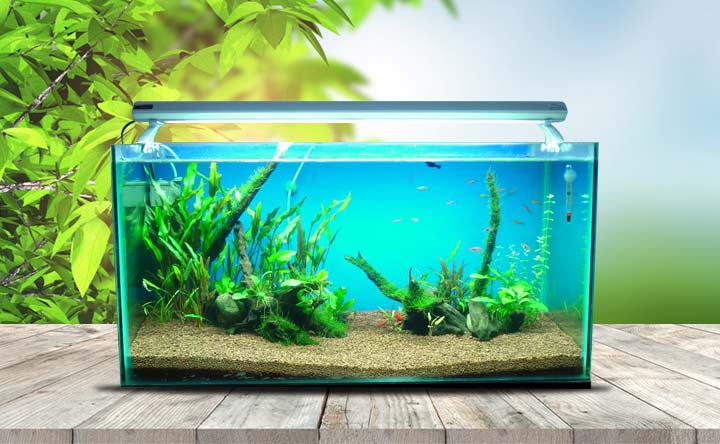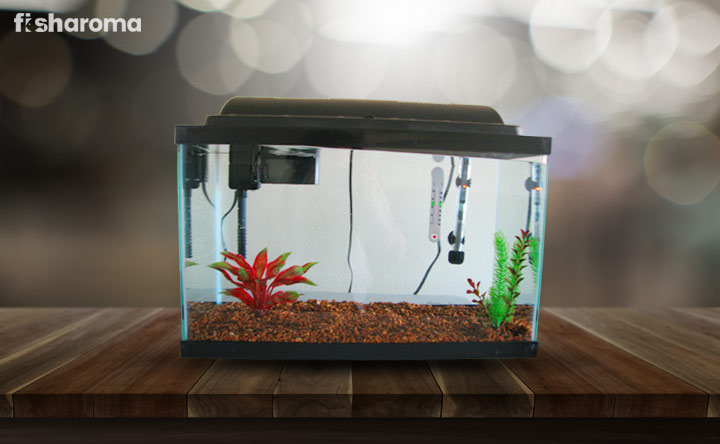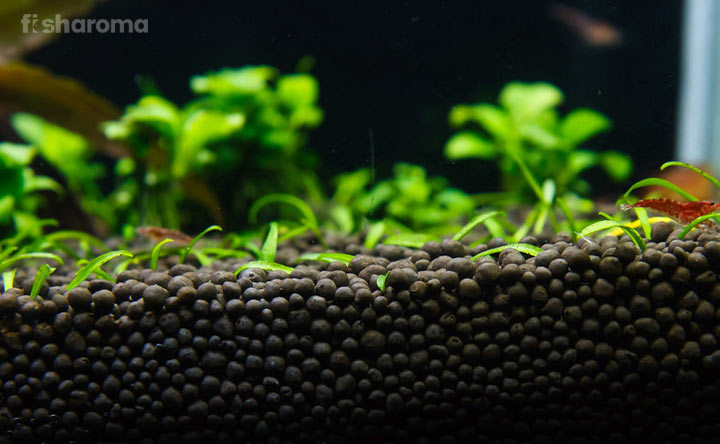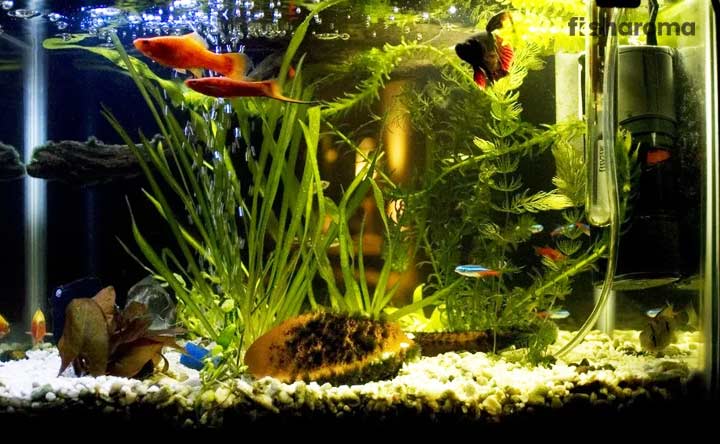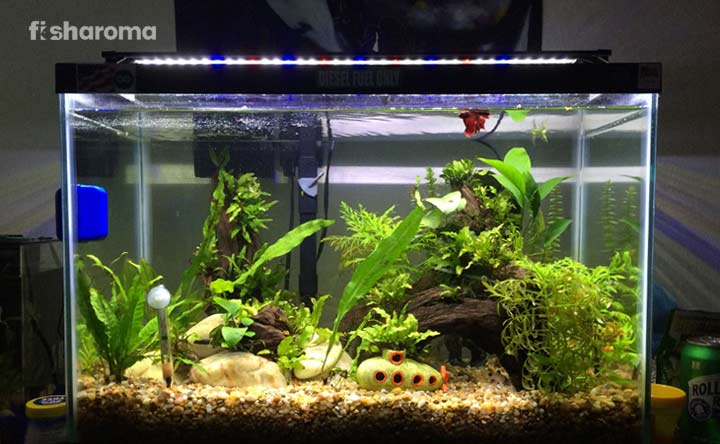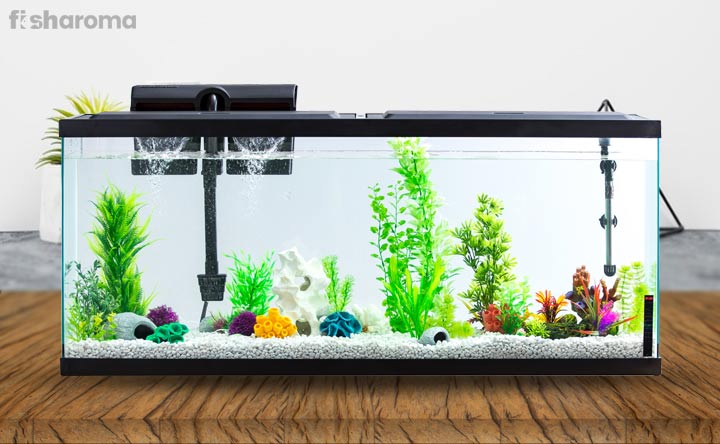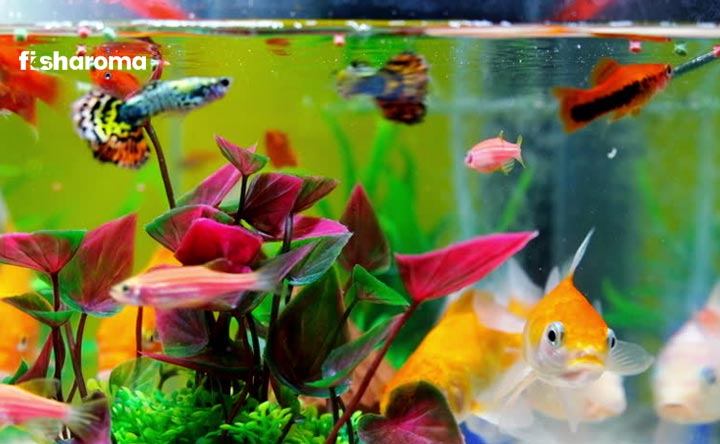11 Common Types of Aquarium Algae – Causes & Effective Treatments

Having an aquarium at home is fun, but maintaining one, is tedious, to say the least. One of the most painstaking tasks that every aquarist has to take once in a while is getting rid of aquarium algae. Extremely tiring to deal with, this aspect of fishkeeping forces many to quit. However, there’s a solution to this, which, if applied effectively, can help you deal with this problem better. So, let us focus on understanding the different types of aquarium algae and how to get rid of them.
What are Aquarium Algae?
Having algae in your aquarium is a natural phenomenon that is bound to hit your aquarium no matter how clean you keep them. But yes, the extent to which they spread and devastate your tank can be totally controlled by you.
But before we prepare you for fighting them, let us help you understand what aquarium algae basically are. Algae are simple living organisms without an organized cell or a DNA structure. Although they are capable of conducting photosynthesis, they lack the physical features of a plant such as leaves, roots, stems, or vascular tissue.
Some forms of algae are important to us since they help us in the survival of animals. However, an overabundance of it can not only be visually unappealing but also prove to be fatal to us. This is the reason algae treatment is one of the crucial aspects of fishkeeping.
The uncontrollable and rapid growth of algae in a body of water is referred to as algae bloom. It should be noted that different algae have to be treated separately. To help you out in fighting algae in your aquarium, we are helping you get acquainted with some of the most common types of algae that frequently attack your tank. In addition, we also are stating what causes them and how can you treat them.
Different Types of Aquarium Algae, Their Causes & Their Treatments
A clear understanding of how the different types of algae work is essential to effectively fight them. In other words, how can you get rid of a particular type of algae if you don’t know what causes its growth?
Thus, we are enlisting the 11 most common types of algae, their causes and their treatments for you.
Blue-Green Algae

Contrary to popular belief, Blue-Green Algae are actually not even algae. They are basically aquatic cyanobacteria. A nitrogen-fixing bacteria by nature, they have the capacity to eventually deplete the nitrogen content of your aquarium tank.
They can spread rapidly in your tank and cover everything in a bluish-green, brown, and/or reddish-purple colored slimy mat. They have an earthy smell to them. Mostly invading the glass wall of your tank where it receives the most light, they can also be seen on the substrate.
Reasons for Blue-Green Algae Bloom
- Over-exposure to light.
- Not changing old light bulbs that emit improper light.
- Low water circulation.
- Lack of water replacement.
- Not removing organic wastes from your tank regularly.
- Excess Nutrient content in your tank.
- Inadequate carbon-dioxide.
How to Get Rid of Blue-Green Algae?
One of the most popular ways of getting rid of Blue-Green Algae is the ‘Blackout’ technique. This remedy is highly effective since Blue-Green Algae can’t survive without light.
For this technique, you need to replace at least 50% of the water content from your tank and remove as many Blue-Green Algae as you possibly can. You then have to test the level of nitrate, and if it is less than 20 ppm, then you have to add adequate potassium nitrate to your tank.
Follow this up by adding an airstone, turning off the lights and covering it up for 3-4 days. After the completion of this period, again replace 50% of the water and remove the airstone.
In addition, keeping fast-growing plants can also deplete the nutrients that these algae thrive on, thereby hindering their growth.
Blue-Green Algae-Eaters
- Mystery Apple Snail
Black Beard Algae

Seen in both saltwater and freshwater tank, Black Beard Algae is a type of Red Algae that produces a red light protein known as phycoerythrin. This protein is what gives these algae the purplish-black appearance.
Extremely slippery by nature, these algae infest driftwood, bogwood, slow-growing plants, as well as on any hard surface of the tank. Attaching themselves firmly to these surfaces, they look like dark gray tufts.
Reasons for Black Beard Algae Bloom
- Carbon-dioxide imbalance.
- Nutrient imbalance.
- Inconsistent lighting.
How to Get Rid of Black Beard Algae?
You can manually remove these algae with the help of an algae scraper. It would be difficult, beware; and if you want, you can use Seachem Flourish Excel to help you with the process.
You can also dip the infected items and plants in a 1:20 ratio of bleach and water solution for 2-3 minutes. In order to keep a check on the level of carbon-dioxide, you can also install a carbon-dioxide system in your tank. Reducing the intensity of the light in your tank also helps in curbing these algae.
Black Beard Algae-Eaters
- Florida Flag Fish
- Amano Shrimp
- Siamese Algae Eater
Green Algae

An umbrella term for all types of algae that are green in appearance (except Hair Algae) Green Algae are known to take multiple forms. Some are easy to wipe off, while others can be extremely stubborn. Although harmless, they can be quite annoying to deal with.
Forming like a layer of green on the glass of your tank, they will keep on resurfacing no matter how hard you try to wipe them off with an algae scraper.
Reasons for Green Algae Bloom
- Overexposure to high-light bulbs.
- Exposure to direct sunlight.
- Lack of macronutrients.
How to Get Rid of Green Algae?
An effective way of curbing a Green Algae bloom is to control the duration of your tank’s exposure to light. Make sure the light of your tank is kept off for at least 12 hours of the day.
Green Algae-Eaters
- Otocinclus Catfish
- Amano Shrimp
- Nerite Snails
Green Algae do have some beneficial features since they house carious micro-organisms who form a crucial part of the diet of various fish.
Brown Algae

Having the ability to survive in low-light conditions, Brown Algae are a form of Diatom and can be seen both in freshwater and saltwater. They also have the ability to obtain nutrients both through chemicals such as nitrates, phosphorous, and silicate; and through photosynthesis.
They start out by appearing as dust on the substrate of your aquarium. Soon within just five days, they turn into a brown-green sticky slimy coat covering the whole substrate, plants, and walls of your tank.
Reasons for Brown Algae Bloom
- Using 100% tap water in our tank.
- An overabundance of phosphates.
- An overabundance of nitrates.
- Overexposure to light.
How to Get Rid of Brown Algae?
You have to be extremely patient while dealing with Brown Algae. You can always start with an algae scraper to get rid of these algae and follow it up by using a piece of soft cloth to wipe off the area. If you see the issue is still persisting, then resort to 50% of water replacement in an attempt to remove the nutrients that these algae thrive on.
If you are using a canister filter, you need to add a spray bar. In case of a HOB filter, you have to use another one since one is not enough. Also, lowering the temperature (without jeopardizing with the health of your aquarium pets and plants) can also help eradicate these algae.
Try to use Reverse Osmosis (RO) water instead of tap water to fill up your tank (or at least a percentage of the tank water). Adding a phosphorous or silicone remover in your tank if there is an excess of phosphorous or silicone respectively can also help in this situation.
Brown Algae-Eaters
- Amano Shrimp
- Otocinclus Catfish
Brown algae are mostly seen in new aquariums.
Hair Algae

Also known as Thread Algae, Hair Algae appear as long green threads which are soft to touch and loose in appearance. They are typically seen anchoring themselves to plants. However, on rare occasions, they can also be seen infesting the decors and gravels of your tank.
Their name has been derived from the fact that when they are taken out of the water they look like wet hair. These fast-growing algae are very hard to get rid of. Hair Algae bloom can result in your tank suffering from a lack of nutrients and light.
Reasons for Hair Algae Bloom
- Nutrient imbalance.
- Lack of carbon-dioxide.
- Overexposure to light, especially, overexposure to a new light source.
How to Get Rid of Hair Algae?
Adjusting the level of nutrients can be one of the steps taken to get rid of Hair Algae. Using a toothbrush to manually remove them is also an effective way to treat them. You can also siphon them out if they are not deeply anchored to the infected areas.
Besides, hosting species that specialize in eating Hair Algae also works here.
Hair Algae-Eaters
- Florida Flag Fish
- Siamese Algae Eater
- Molly
- Amano Shrimp
- Dwarf Shrimp
Green Water

It is basically a situation when the water in your aquarium turns completely green. This situation is mainly caused by small, free-floating algae that add a green stain to the tank water. These algae belong to the genus Chlorella.
An interesting aspect about these algae, which also makes it very hard to deal with, is that they do not settle on hard surfaces.
To put it simply, they are a bloom of unicellular algae that grow and sustain themselves through photosynthesis. They replicate rapidly since they are a singular cell organism. Ignoring the growth of these algae can have disastrous results in your tank.
Reasons for Green Water
- A spike in lighting.
- An overabundance of nutrients.
- Irregular water replacement.
How to Get Rid of Green Water?
Simple replacement of water is not a solution here since it is a single-cell organism. Even changing all of the water at once (which can be stressful for the plants and animals inside the tanks) doesn’t work here since these algae will resurface after 2-3 days.
What you need to do here is use a UV sterilizer or conduct a blackout procedure (the steps of which can be found in ‘Blue-Green Algae’ section above).
Green Water Algae-Eaters
- Shrimps
- Snails
Green Spot Algae

Ever seen tiny green spots on the walls of your fish tank? Well, the next time you notice any, just understand that you are looking at Green Spot Algae.
Apart from the tank walls, they also appear on the decors and slow-growing plants of your tank. What starts as tiny dots, eventually results in forming a thick coat all over your tank. They form as extensive algae crusts that are extremely hard to get rid of.
Reasons for Green Spot Algae Bloom
- Imbalance of nutrients, especially a low level of phosphates.
- Poor water circulation.
- Low carbon-dioxide.
- Overexposure to high-intensity light.
- Inadequate fertilization.
- Irregular water replacement.
How to Get Rid of Green Spot Algae?
Since a low level of phosphates is one of the biggest reasons behind the growth of this algae, increasing its level to an adequate amount can help. However, having said that, do not overdose your tank with phosphates. Using Seachem Flourish Phosphorus can help check its level.
After adjusting the level of phosphates, you can remove these algae with the help of an algae scraper. Do keep a close look to see if it returns. Furthermore, make sure that your lights don’t stay on for more than nine hours a day.
Green Spot Algae-Eaters
- Sun Snail
- Nerite Snail
Green Dust Algae

Also known as Green Glass Pest, the Green Dust Algae form a slippery slime over the tank walls. They are often confused with Green Spot Algae; but there are significant differences between the two of them. Unlike Green Spots, Green Dusts do not grow in spots. Instead, they spread like a coat over hard surfaces.
If you try to scrape them off the wall, they will settle at the bottom of your tank as dust (hence their name), before reappearing as new coat.
Reasons for Green Dust Algae Bloom
- Absence of beneficial bacteria.
- If your tank is not cycled properly.
- Imbalance of carbon-dioxide.
- Imbalance of nutrients.
How to Get Rid of Green Dust Algae?
Ideally, you just need to practice patience, do nothing, and let the algae run its full life cycle. Approximately, it takes around four weeks for this algae to complete its life cycle. During this period, try not to scrape off or wipe off these algae. This is because doing so, it will release spores and restart its life cycle.
After the completion of four weeks, replace the water and wipe the glass clean, removing the algae in the process. In addition, try to replace the light after the change of the water, if possible. Although it hasn’t been scientifically proven that it will directly help in controlling these algae, some people believe in it.
Green Dust Algae-Eaters
- Otocinclus Catfish
- Nerite Snail
- Amano Shrimp (to an extent)
Rhizoclonium Algae

Rhizoclonium Algae form as fine brown or greenish strands, similar to Hair Algae, that are soft to touch and slimy in texture. These algae are genus of the Green Algae, specifically of the Cladophoraceae.
Reasons for Rhizoclonium Algae Bloom
- Low level of nutrients
- Imbalance of carbon-dioxide.
- Poor water circulation.
- Lack of overall tank maintenance.
How to Get Rid of Rhizoclonium Algae?
You need to start by cleaning your tank and follow it up by checking on its nutrient level, and based on that, adjusting its level. If the level of carbon-dioxide is low, then you need to increase it while also making sure not to increase it to a level that would create a toxic level for the fish inside. Furthermore, you can also follow the ‘How to Get Rid of Black Beard Algae’ section to understand how to fully get rid of these algae.
Rhizoclonium Algae-Eaters
- Amano Shrimp
Staghorn Algae

Evident by their name, Staghorn Algae resembles the horns of a stag and are found on plant leaves, aquarium equipment, and décor. They belong to the Red Algae group and are greyish in appearance.
The threads of these algae grow long and bushy overtime. They are also known for their firm grip on the surface they attach themselves to.
Reasons for Staghorn Algae Bloom
- Poor water flow.
- Low level of carbon-dioxide.
- Nutrient imbalance.
- High level of ammonia.
How to Get Rid of Staghorn Algae?
Staghorn Algae are extremely difficult to get rid of, wherein manual removal doesn’t work most of the times.
Bleach treatment can help you out in tackling these algae. To do this, you need to dip the affected plant and/or other affected items in a 1:20 solution of bleach and water for 2-3 minutes and wash it off with clean water.
Remember, once you get rid of the algae, maintenance can help prevent them from resurfacing. Thus, regularly change the water of your tank, and increase the level of carbon-dioxide to the adequate level and maintain a balanced level of nutrients in your tank.
Staghorn Algae-Eaters
Unfortunately, there isn’t a single species that will consistently eat Staghorn Algae. Shrimps might eat them once in a while, but you defientely can’t count on them to get rid of these algae. However, shrimps do eat up the dead remains of Staghorn Algae.
Fuzz Algae

Growing as short individual filaments, Fuzz Algae are mainly seen on aquarium décor, walls, and plant leaves. They are identified by their fuzzy green appearance.
Although a small population of these algae is beneficial to the tank, an abundance of it can result in a disaster for the life inside the tank.
Reasons for Fuzz Algae Bloom
- Lack of nutrient.
- Low level of carbon-dioxide.
How to Get Rid of Fuzz Algae?
If you optimize your fertilizing regimen, these algae can be quite easily removed from your tank. Check the level of carbon-dioxide and nutrients in your tank and adjust them to their adequate level to make sure the elimination of these algae from your tank.
Fuzz Algae-Eaters
- Black Molly
- Otocinclus Catfish
- Siamese Algae Eater
- Bristlenose Pleco
- Amano Shrimp
Summary
Algae bloom is like a forest fire. They will spread uncontrollably in a blink-and-miss moment. We hope with our guide of the 11 most common types of aquarium algae, you have a better understanding of how to deal with these aforementioned algae and save your tank and pet from algae infestation. Remember, the key idea here is to stop an algae bloom. Thus, taking early preventive measures that we have mentioned here will help you eradicate them easily.
Similar Fishkeeping Articles
Take a look at some of our other fishkeeping guides.
- Best Algae-Eaters – Get to know the best algae-eaters that you can host in your aquarium.
- How to Set Up a Fish Tank – Let us help you prepare in an efficient manner for setting up a fish tank.
- Saltwater vs. Freshwater Aquariums – Separate the myths from the real facts about the distinction and similarities between saltwater and freshwater tanks.

